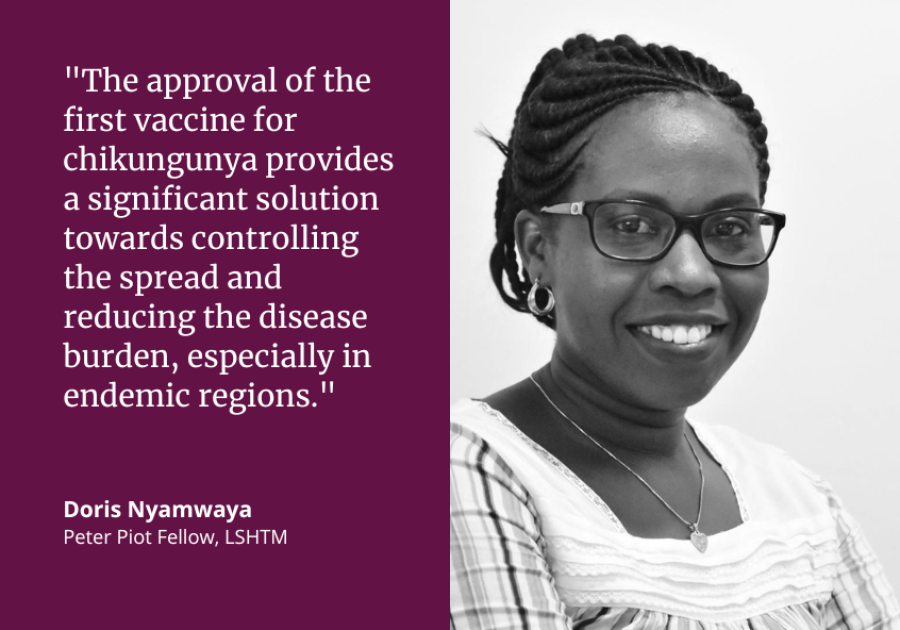Expert Comment – First chikungunya vaccine approved
22 November 2023 London School of Hygiene & Tropical Medicine London School of Hygiene & Tropical Medicine https://lshtm.ac.uk/themes/custom/lshtm/images/lshtm-logo-black.png
The world’s first vaccine for chikungunya, which is seen as a growing threat to public health, has been approved by the US Food and Drug Administration.
Chikungunya virus is spread by mosquitoes and causes symptoms including fever and joint pain. There is no specific antiviral drug for the disease. It can lead to severe, long-term problems, and in some cases can be fatal. In 2023 so far, 440 000 cases and over 350 deaths have been reported worldwide.
With climate change and other population changes, the Aedes mosquitoes which carry the virus are expanding into new geographical areas. Chikungunya was first identified in Tanzania in 1952, but is now found in over 110 countries across Africa, Asia, the Americas and Europe.
Dr Doris Nyamwaya, Peter Piot Fellow for Global Health Innovation: Epidemic Preparedness and Response at LSHTM, is based at the MRC/UVRI & LSHTM Uganda Unit where she is researching chikungunya.
She said: “Emerging infectious diseases are a major challenge to global health due to a lack of established prevention and control measures. The approval of the first vaccine for chikungunya provides a significant solution towards controlling the spread and reducing the disease burden, especially in endemic regions.
“Ixchiq is a live-attenuated, single dose vaccine that is designed by deleting a part of the chikungunya virus genome. This vaccine would benefit inhabitants of endemic regions especially in low- and middle-income countries who bear the greatest burden of the disease. Additionally, travellers to affected regions can be protected.”
Dr Nyamwaya pointed out, however, that the new vaccine is only for adults, and highlighted the need for more research into length of protection and the specific ways in which the virus affects people in different parts of the world, for example Africa.
She said: “Considering the less developed immune system of young children, they bear a huge burden of severe complications that can lead to death or developmental delays. We need a protection strategy for children.
“Studies from the African continent have reported occurrence of reinfections but with genetically distinct strains of chikungunya virus. It is important to have efficacy trials of the vaccine in different geographical locations, especially in Africa where the West African strain is confined.”
Hyolim Kang, a research degree student at LSHTM who is assessing chikungunya vaccine impact for her PhD, said: “Since 1952, chikungunya outbreaks have been reported in over 110 countries, predominantly affecting tropical and sub-tropical regions. Historically, Africa and Asia experienced numerous outbreaks, with a notable surge in the Indian Ocean region during 2005-2006. Since 2013, chikungunya fever has rapidly spread in the Americas, with South and Central American countries facing a significant disease burden as of 2023. The countries reporting the highest number of chikungunya cases in 2023 include Brazil, Paraguay, Argentina, and Bolivia.
“The increasing climatic suitability for Aedes mosquitoes contributes to their enhanced reproduction and habitat expansion, potentially introducing chikungunya to regions where it has not been previously reported. Since the beginning of the 21st century, chikungunya has increasingly become a concern for travellers, as evidenced by the importation of the virus to non-endemic areas such as Europe and North America.”
Explaining how the virus spreads and interacts with humans, mosquitoes and wild animals, she said: “The virus is primarily transmitted to humans via bites from infected Aedes aegypti and Aedes albopictus mosquitoes, serving as vectors.
“The transmission of chikungunya involves a complex interplay among the vector, hosts, and the environment. In urban cycles, transmission to humans is amplified through the bites of female Aedes aegypti and Aedes albopictus mosquitoes. In enzootic or sylvatic cycles, non-human primates such as rats, monkeys, or birds act as virus reservoirs. This allows the possibility of spillover to humans after periods of dormancy.
“Countries like Uganda and Senegal have established sylvatic cycles involving non-human primates and forest-dwelling mosquitoes. However, there is currently no concrete evidence of chikungunya existing in sylvatic cycles in Asia or the Americas.”
LSHTM's short courses provide opportunities to study specialised topics across a broad range of public and global health fields. From AMR to vaccines, travel medicine to clinical trials, and modelling to malaria, refresh your skills and join one of our short courses today.